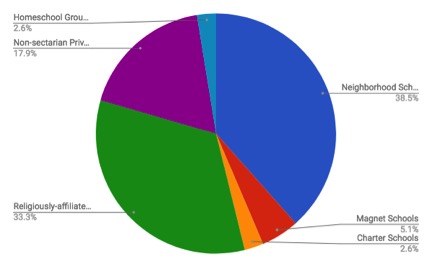 Litzsinger Road Ecology Center has the privilege of partnering with teachers from all types of schools, all across the St. Louis region: magnet schools, a charter school, and a number of other public and private schools located in 12 of the 22 St. Louis County school districts as well as St. Louis Public Schools in the city.
Litzsinger Road Ecology Center has the privilege of partnering with teachers from all types of schools, all across the St. Louis region: magnet schools, a charter school, and a number of other public and private schools located in 12 of the 22 St. Louis County school districts as well as St. Louis Public Schools in the city.
This article is an attempt to to answer the title question recently posed by a Volunteer Educator about the various types of schools in St. Louis.
There are two primary types: public and private.
Public schools are funded by taxes: Local property taxes, state and federal. Basically, we all fund these schools. Public schools follow curriculum and evaluation guidelines established by the state of Missouri. There are three types: neighborhood, magnet, and charter. In Missouri, charter schools are limited to St. Louis City and Kansas City.
Your child is assigned to a neighborhood school based on your address. The vast majority of public schools are neighborhood schools.
Magnet schools can attract students from any neighborhood in the district. Each of these schools emphasizes certain subjects, a particular educational approach, or theme—for example: Northwest Academy of Law. An application is required and because of their popularity, spots are allocated by lottery.
Charter schools are governed by an independent school board in partnership with a sponsor and a management organization. A charter school sponsor is a local educational institution—like UMSL—charged by state law with ensuring that the charter school meets the student achievement goals and financial and operational standards required by the contract (charter) made between the charter school and the sponsor. Charter school management organizations—like KIPP—help charter schools with hiring, purchasing and fundraising. By providing these services to more than one school, they make them more affordable by an economy of scale. Charter schools are not managed by the school district. This independence allows each charter school a lot more freedom in how they operate, the curriculum they choose, and how they serve their students. Some schools have themes and/or a geographic enrollment focus. Advanced application is required and spots are usually allocated by lottery. Read Charter School 101: The Basics.
Private (non-public) schools are funded by charging tuition for each student. Tuition income is often supplemented by donors: foundations, corporations and individuals. Private schools may be religiously affiliated or non-sectarian. In Missouri, the most common religiously affiliated schools are Roman Catholic (49%), Lutheran (14%) and other Christian (18%). Non-sectarian schools are not affiliated with a particular religion.
Another school option is Homeschool. LREC currently partners with a network of homeschool families. Read Homeschoolers Spotted at LREC.
Here’s a rundown of LREC-affiliated schools:
Neighborhood Schools: 15
Magnet Schools: 2
Charter Schools: 1
Religiously-affiliated Private Schools: 13
Non-sectarian Private Schools: 7
Homeschool Groups: 1
